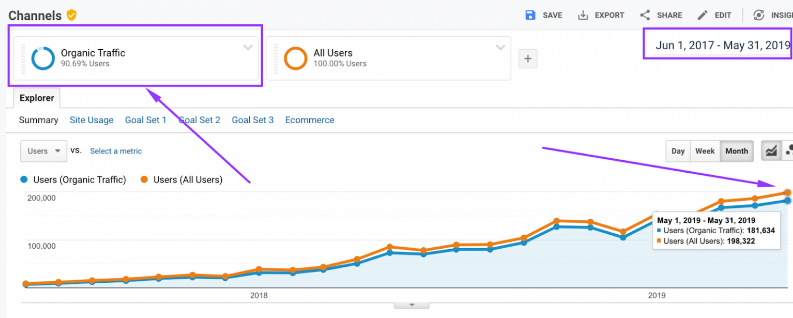Looking for a successful SEO case study?
Something that shows the exact process, tactics, and results?
This is exactly what we have in our chapter today. We’re going to give you a taste of the SEO results Apollo Digital achieved on a business process management software client that was receiving about 8,000 monthly organic search visits.
By implementing these same strategies, they are now receiving over 200,000 organic search visits per month.
Auditing Existing Keyword Strategy
You can easily start this process by auditing your existing keyword strategy to find gaps in your coverage, then performing competitive research to uncover new opportunities.
Most of the keywords included should have medium to high traffic, low competition, and high CPC. This is going to give you more traffic and boost the performance of your SEO investment.
Content Audit for Existing Content
A content audit aims not to eliminate existing content but to improve them to create better reading experiences for users interested in your topic. If you have a lot of content on your site from previous campaigns, then it’s worth spending some time to go through each piece of content and look at how it performs.
It then makes sense to redirect poor-performing content to a more relevant page.
New Content Marketing Direction for Future Content
After they optimized all existing content for the client, their next job was to make sure that this was not a one-off change. They vetted the writers that would produce the new content and then ensured that they would deliver content that was at least as good as they had already created. They did this by:
Creating Content Outlines
Google ranks content, not just pages. As a result, you need to write your articles to rank them, not just publishing them. To do this, you need to figure out precisely what topic will be searched for on Google and how a reader will search that topic for.
So, they created outlines for each keyword that contained a list of sub-topics that they must cover in the article. This made it much easier to create content because writers knew exactly where you needed to go from point A and point B.
Establishing Writer Guidelines
First, identify the common mistakes writers make when writing for Search Engine Optimization, then create a list of things that you do not want in your content. For example, writing 3-4 lines in paragraphs, no filler content, grammatical errors, or passive voice, and prioritizing main keywords.
This helped create content that was attractive to both Search Engines and readers.
Successful Internal Cross-Linking
Internal linking is an essential part of web page optimization as it allows you to improve the flow of one page to the next, which is crucial for user experience.
Building incoming backlinks are still important, but it’s also essential that the right content is linking to each other. This is especially true with new content–which should be linked to and from older content pieces.
Ensure that new content links to existing content, and you also link to other relevant posts on the site when creating a new blog post.
Making Blog Visuals & Readability Better
It’s time to end the plague of stock images and long paragraphs on your blog and replace them with relevant, customized imagery. You can add visual aids such as graphs, tables, and charts by using Draw.io and Canva.
These made a HUGE difference to our site’s visuals, making it much more digestible for our users and improving the reading experience.
Keep Track and Improve
The first thing someone sees when they land on our blog is the headline of an article. So, it is crucial then that your headlines be as catchy as possible. Thus, it is essential to keep updating data and changing the headlines based on Google Search Console click-through rates (or CTR).
Our Say

SEO work is never truly finished. Watching your rankings in Google closely is crucial. After identifying issues, make adjustments to the page that best suited your needs.
This could be as simple as making edits to improve the user experience or stay current with Google’s algorithm updates. It’s how you truly succeed in increasing organic traffic!

